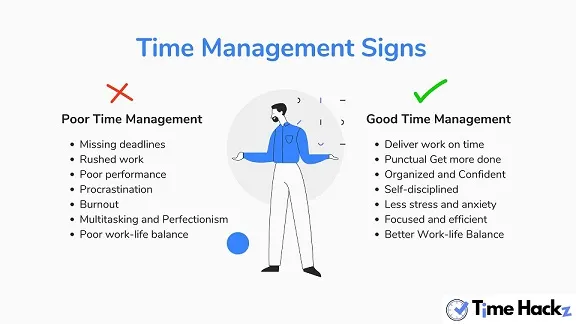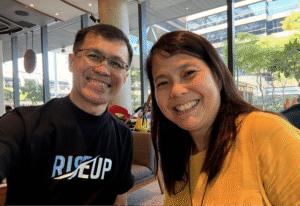It’s 8:30 PM on a Wednesday, and you’re a new manager—recently stepping into a leadership position at a bustling Singaporean tech firm. The boardroom is still illuminated, your phone buzzes with phone calls demanding immediate attention, and your inbox brims with messages about “urgent” issues.
Outside, the city lights reflect a life you haven’t touched in days. You scan your to-do list and feel there aren’t enough hours to tackle these complex tasks.
Now, consider Alex—a newly minted co-founder in another rising startup. By 2 AM, he’s still at his desk, sifting through endless meeting notes and battling missed deadlines on specific tasks that are pivotal to the firm’s survival.
Exhausted, he wonders if he’ll ever gain control over his week. That sense of drowning? It’s not just Alex’s story. It’s a leaders’ journey familiar to many who lack time management skills—the ability to effectively prioritize tasks, save time, and monitor progress while preserving their well-being.
A 2025 study in Harvard Business Review reveals that effective leadership hinges on strong time management strategies. In Singapore, middle managers spend 35% of their day in unproductive sessions, while public sector heads dedicate a hefty 41% to administrative tasks, leaving little scope for important tasks and leadership development.
This results in slower growth, complex tasks piling up, and a perpetual feeling that there’s never enough time to focus on what makes the greatest impact. For Alex—and countless others—this life pattern eventually leads to lost performance, higher stress, and waning team effectiveness.
Real-World Failures of Time Mismanagement
Time has a way of slipping through the cracks—especially when you’re juggling competing demands. For leaders, how time is spent can make or break outcomes. It’s not just about being busy; it’s about focusing on what truly matters. When that balance is off, the effects can be bigger than expected.
Pirate3D: When Missed Deadlines and Lost Focus Doomed a Startup

Pirate3D, a Singapore startup, raised $1.5 million on Kickstarter in 2013 to produce the Buccaneer 3D printer. However, by 2014, most backers were still waiting for their units, even as the company sold printers through retail.
Co-founder Brendan Goh later admitted they had “bit off more than we could chew”, attempting to build an entire ecosystem instead of focusing on the core product. Management became reactive—fielding complaints and seeking emergency funds—rather than executing on fixes.
Despite promises to raise capital and fulfil orders, Pirate3D ran out of money by late 2015. Analysts cited a “tremendous lack of focus” as the key factor behind its collapse. Pirate3D remains a cautionary tale of how missed deadlines and reactive leadership can derail even the most promising startups.
Public Sector Turnover Spike

A key government agency experienced a 20% rise in resignations among newly promoted staff. Exit interviews emphasized “constant firefighting” and inadequate frameworks to prioritize tasks.
Many lamented that their leadership positions provided no training in enhancing leadership skills, such as scheduling or how time management helps.
Harvard Business Review insights also indicate high stress levels among workers under 35, stemming from gaps in time management skills and leadership for manager roles.
Yahoo - Micromanagement Over Strategy

Yahoo’s failed turnaround in the 2010s shows how poor time management at the top can derail a company. CEO Marissa Mayer focused on low-impact projects like Yahoo’s weather app, diverting attention from fixing its core ad and search business.
Instead, she invested time in splashy ventures and product tweaks that insiders said were unlikely to make a real impact.
This micromanagement and lack of strategy stalled progress and blocked a meaningful comeback. Ultimately, Yahoo’s core assets were sold to Verizon in 2017 for $4.48 billion—a fraction of its former value.
Why Time Management Makes or Breaks Leaders

Despite Singapore’s reputation for productivity, many managers still equate busyness with results.
However, Harvard Business Review notes that leaders who spend time effectively—by setting clear goals, focusing on people management skills, and protecting regular breaks—attain significant impact on teams, drive how to strengthen leadership skills and foster work-life integration.
The Cost of Poor Time Management
Burnout and Well-Being: Stress is taking a toll on young workers’ health. About one in three young adults report experiencing severe stress or anxiety symptoms, underscoring the importance of self-care.
Stagnant Innovation: Poor time management can stifle creativity by roughly 40%. Research shows that on high-pressure, chaotic days (often a result of disorganized leadership), people are about 45% less likely to think of new ideas or solve problems creatively.
Talent Drain: A significant share of employees will quit when leadership is disorganized. In one global survey, 56% of workers who quit cited “poor management” as a top reason, and 49% cited a lack of work-life balance (often a symptom of excessive workloads and poor time allocation)
Alex felt these ramifications daily. He lost track of broader projects by prioritizing minor matters over important tasks, damaging investor relations and demoralizing his team members.
As his stress level spiked, he realized that effective time management was crucial for organizational success and personal well-being.
5 Science-Backed Strategies for Time Mastery

Below are proven time management strategies tailored to new managers’ challenges in Singapore. Each technique underscores how to make the most precious resource—time—work in your favour.
1. President Dwight D. Eisenhower’s Priority Matrix
The Science
Adopting Eisenhower’s urgent-vs-important matrix can substantially reduce “firefighting” reactive work. For example, one team that rigorously prioritized high-value tasks reported a 40% reduction in reactive busywork after 90 days. By systematically focusing on what truly matters (and deferring or delegating the rest), leaders free up time otherwise lost to constant fire drills.
Quadrant | Action | Example Tasks |
|---|---|---|
Urgent & Important | Do immediately | Crises, regulatory deadlines |
Important, Not Urgent | Schedule | Strategic planning |
Urgent, Not Important | Delegate | Routine approvals |
Neither | Eliminate | Low-value emails |
How It Works
Urgent & Important (Needs immediate action—crises, regulatory deadlines)
Important but Not Urgent (Long-term leadership development, strategic brainstorming)
Urgent but Not Important (Routine approvals, phone calls that could be delegated)
Neither (Eliminate these to save time)
CEO Blueprint
For example, Carlos Ghosn (former Nissan CEO) was notorious for disciplined time management. He limited most meetings to no more than 90 minutes – 45 minutes to present an issue and 45 to decide – to keep focus on critical matters.
This kind of structured scheduling mirrors the priority matrix approach, ensuring that truly important issues (urgent crises or long-term strategy) first received dedicated attention.
Leaders’ Journey Example
Alex shed non-critical tasks and used the matrix to identify only the ones with the greatest impact. Within weeks, he regained valuable hours for practical leadership projects and personal self-care.
2. Time Blocking for Maximum Control
The Science
Time blocking—scheduling your day into dedicated focus blocks—is proven to boost productivity. Giving people uninterrupted work periods for important tasks leads to tangible gains. For instance, when one company implemented a “no-meetings” day (allowing employees a solid block for focused work), productivity jumped about 15%.
How to Implement
Peak Hours: Reserve your most alert times—often mornings—for difficult tasks and projects requiring deep focus.
Regular Breaks: Insert 10–15 minute breathers between tasks to prevent decision fatigue.
Short Blocks: Even 15-minute increments help you manage specific or short-term tasks that otherwise stall your flow.
Example of Leadership Skills Application
Some organizations have introduced policies like “No-Meeting Wednesday” to give teams more focus time. This approach can noticeably improve outcomes. In one internal study, removing meetings one day a week led to a 15% boost in productivity (as employees had more uninterrupted time for priority work).
By carving out meeting-free blocks, leaders ensure they and their teams spend that time on clear, value-added priorities.
Leaders’ Journey Example
Alex discovered that dedicating uninterrupted 90-minute blocks to product innovation boosted teams’ morale and let him “buy time” later for self-care activities like exercise or reading—a small step toward better work-life balance.
3. Delegation and Accountability: How to Build Leadership Skills
The Science
Smart delegation significantly improves leaders effectiveness and efficiency. Research shows that organizations where managers delegate effectively are about 22% more productive than those where leaders try to do it all.
In short, learning how to enhance leadership skills and entrust tasks to your team is good for morale and frees up substantial time for leaders to focus on high-impact work.
Role | Responsibility |
|---|---|
Responsible | Executes the task |
Accountable | Oversees outcomes (typically the leader) |
Consulted | Provides input |
Informed | Kept up-to-date |
Action Steps
RACI Matrix: Clarify roles—Responsible, Accountable, Consulted, Informed—to remove ambiguity and provide accountability.
Identify Specific Tasks: Pinpoint tasks someone else can do as effectively or better.
Set Clear Goals: Make sure delegated tasks have clear priorities and timelines.
Why It Matters
Leaders who try to handle everything often miss deadlines and experience high stress. By offloading routine duties, you save time and develop your team’s skills—a crucial aspect of leadership and teamwork.
Leaders’ Journey Example
Initially hesitant, Alex finally delegated routine financial admin to his CFO. This freed him to focus on significant product innovation, showcasing leadership skills examples where trusting people’s manager on the team fosters collective success.
4. Proactive Time Budgeting for the Greatest Impact
The Science
Proactive time budgeting for strategy pays off. When leaders consistently set aside substantial time for strategic thinking and big-picture projects, their teams tend to be far more engaged.
Conversely, many teams suffer from a lack of direction—Gallup found that only 22% of employees feel their leaders have a clear direction for the organization.
Dedicating regular “strategy time” (e.g. CEO think sessions or retreats like Bill Gates’s famous “Think Week”) helps clarify that direction, which in turn boosts team engagement and alignment.
Practical Methods
Think Weeks: Emulate Bill Gates’ retreats for deep introspection and leadership development.
AI Tools: Alibaba’s scheduler predicts durations for each task to preempt overcommitment, allowing leaders to improve productivity.
Local Tech Integration
Singapore’s GovTech “TimeTrack” reveals how managers spend each week and advises strategic rearrangements—a boon for how effective time management helps accomplish short- and long-term targets.
Leaders’ Journey Example
Reserving one Friday a month for vision-setting gave Alex the mental space to chart new business expansions, boosting his leadership skills and reaffirming his team’s support in large-scale projects.
5. Effective Meeting Management: How to Strengthen Leadership Skills
The Science
Effective meeting management saves hours. Today’s executives spend an average of nearly 23 hours per week in meetings (up drastically from past decades), so improving meeting practices has a huge upside.
Simply enforcing clear agendas and stricter time limits and only allowing necessary attendees to reclaim a significant chunk of that time.
Even a 10% reduction in meeting time is like giving each leader 2+ hours a week to spend on real work. In short, better-run meetings equal more time for everything else.
Key Practices
24-Hour Rule: Decline any meeting invite lacking a circulated agenda or materials one day prior.
15-Minute Standups: A short, structured talk ensures everyone knows priorities and can adjust accordingly.
Follow-Up Clarity: End with “Who does What by When” to monitor progress and keep everyone accountable.
Project Manager Skills Application
Some organizations use technology to streamline meetings. (For example, Salesforce and other tech firms have experimented with automated agenda tools to keep meetings on track.)
While proprietary results aren’t public, the goal is to reduce meeting lengths sharply – one company reported cutting average meeting duration by about 40% after enforcing timed agendas and clear outcomes for every meeting. (Source: www.cbsnews.com)
The takeaway: using tools or strict facilitation can make meetings shorter and more purposeful, so teams spend less time sitting in conference rooms and more time executing.
Leaders’ Journey Example
When Alex implemented quick daily huddles, his team members found they could manage their time effectively to achieve more and solve complex tasks faster. This shift also reduced the overall stress level in the office, proving that time management can significantly improve productivity.
Success Stories: Proof It Works

Microsoft’s Four-Day Workweek Experiment
Tech giant Microsoft’s Japan division famously piloted a 4-day workweek (giving employees Fridays off) and saw productivity soar by 40% during the trial.
In cutting out a day of work, they also shortened meetings (capped at 30 minutes) and streamlined workflows, proving that working smarter (with focused time and ample rest) can dramatically boost output without burning out the team.
This real-world “less is more” example shows how deliberate time restructuring can yield significant performance gains.
Tencent’s AI-Powered Scheduling
Chinese tech leader Tencent leverages artificial intelligence to automate scheduling and prioritize tasks. The result? Faster decisions and less time wasted in coordination. In fact, companies implementing AI-driven scheduling report an average 30% improvement in operational efficiency.
Tencent’s approach illustrates how smart use of technology and time management tools can streamline cross-department projects – accelerating workflows and reducing the delays and challenges that often plague large organizations.
Singapore’s Public Sector Transformation
In Singapore’s government, leaders recognized that overwork and inefficient practices were straining employees. The Civil Service College introduced time management workshops as part of a “Work Smarter” transformation initiative.
After emphasizing priority-setting and efficient meeting practices, some agencies dramatically cut overtime hours and saw more projects completed on schedule.
In other words, by training public-sector managers to manage their time like a precious resource, the government reduced burnout and improved performance in delivering services – a win-win for employees and citizens alike.
Source: www.knowledge.csc.gov.sg
Pitfalls to Avoid

Over-blocking
Scheduling every minute of your day can backfire. Research shows you should leave about 20% of your work time unscheduled to handle unexpected issues and creative opportunities.
Suppose you jam-pack 100% of your calendar. In that case, any surprise (a crisis email, a brilliant idea worth pursuing) will throw you off. Give yourself buffer windows to adapt – you’ll stay sane and innovative.
Mis-delegation
Delegating tasks is smart leadership, but only if responsibilities are clear. Without clarity, hand-offs lead to confusion, friction, or missed deadlines. In fact, a lack of role clarity often causes work to be done incorrectly or duplicated, wasting time.
To avoid this, establish an accountability framework for your team. Many managers use the RACI matrix (Responsible, Accountable, Consulted, Informed) process to define who’s doing what.
Clear ownership of tasks ensures nothing falls through the cracks and prevents the “I thought you were handling that” syndrome.
Agenda Ambiguity
Nothing drains time like an aimless meeting. Yet around 60% of meetings lack a structured agenda, leading to meandering discussions that accomplish little. Don’t let “meeting creep” devour your day.
Insist on a focused agenda and a time limit for every meeting. Circulate pre-read materials if needed, and assign a timekeeper to keep discussions on track. With a clear purpose (and endpoint), meetings become efficient decision-making sessions instead of endless time sinks.
How Time Management Helps Strengthen Leadership for Managers
Effective time management isn’t just about getting more done – it’s about becoming a better leader. By strategically managing your time and energy, you sharpen several core leadership skills:
Sharp Focus on Priorities: Great leaders excel at identifying what matters most. Planning your day and week around high-impact activities ensures your energy goes to initiatives that move the needle. Research shows that time management is significantly correlated with improved job performance . When you focus on priorities rather than reacting to every distraction, you deliver stronger results on key goals.
Better Decision-Making (Urgent vs. Important): Time management forces you to confront the difference between what’s urgent and truly important. Using tools like Eisenhower’s Priority Matrix, you learn to delegate or defer trivial urgencies and make room for strategic thinking. The result is more thoughtful decisions. You’re not constantly firefighting; you’re proactively steering the ship.
Multi-Project Handling and Team Coordination: Leaders often juggle multiple projects. Adopting techniques like time-blocking and setting aside dedicated slots for each project will help you handle this load with less stress. You also clarify team roles and deadlines in the schedule, which improves team coordination (everyone knows what to do when). When managers manage their time well, it cascades to the team – meetings start on time, deadlines are met, and people aren’t stuck waiting on an overbooked boss.
Reduced Stress and More Empowered Teams: Perhaps most importantly, purposeful time management improves your well-being as a leader and that of your team. Studies find that when professionals feel more in control of their time, their stress levels drop. You’ll be calmer and more present with your team instead of frazzled. By modeling good time habits (like taking lunch breaks or leaving work at a reasonable hour), you signal to your team that work-life balance is valued. An organized, less-stressed leader inspires confidence – and an empowered, productive team – much more than a harried one does.
When you manage time purposefully, you amplify your leadership. You make room to strategize, to mentor employees, and to think creatively. In short, what are leadership skills you stop just “managing work” and start truly leading. The payoff is a more effective organization and a more rewarding work life for everyone involved.
Final Thought: Lead Smarter, Not Harder
In Singapore’s fast-paced business environment, effective leadership demands not just hard work but smartly allocated hours.
As President Dwight D. Eisenhower—famous for his priority matrix—once practiced, “Plans are worthless, but planning is everything.”
This ethos resonates strongly with Alex’s journey and countless others: by setting clear priorities, carving out regular breaks, and focusing on the tasks that have the greatest impact, leaders retain better control over their schedules, reduce stress, and see real performance gains.
Your First Step
- Identify One Low-Value Task: Remove or delegate an item from your to-do list that isn’t yielding significant impact.
- Use Time Blocking: Schedule a 90-minute focus block for difficult tasks or projects—and guard it fiercely to improve productivity.
- Apply Accountability Structures: For your next meeting, use a concise, agenda-focused approach to ensure clear priorities and a plan to monitor progress.
Track the difference over one week. Watch how regular breaks, disciplined scheduling, and time management help foster more decisive leadership for manager roles. You’ll likely see improved life balance, heightened team effectiveness, and a renewed sense of control—a testament to what makes a great leader great.







